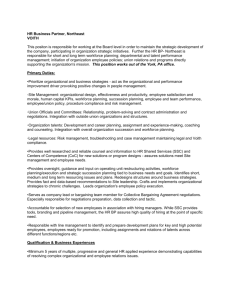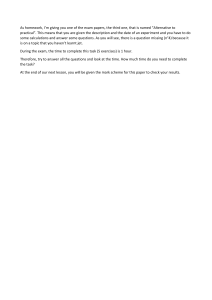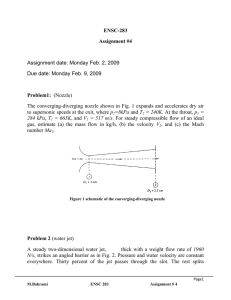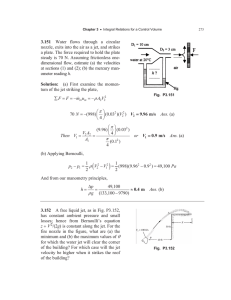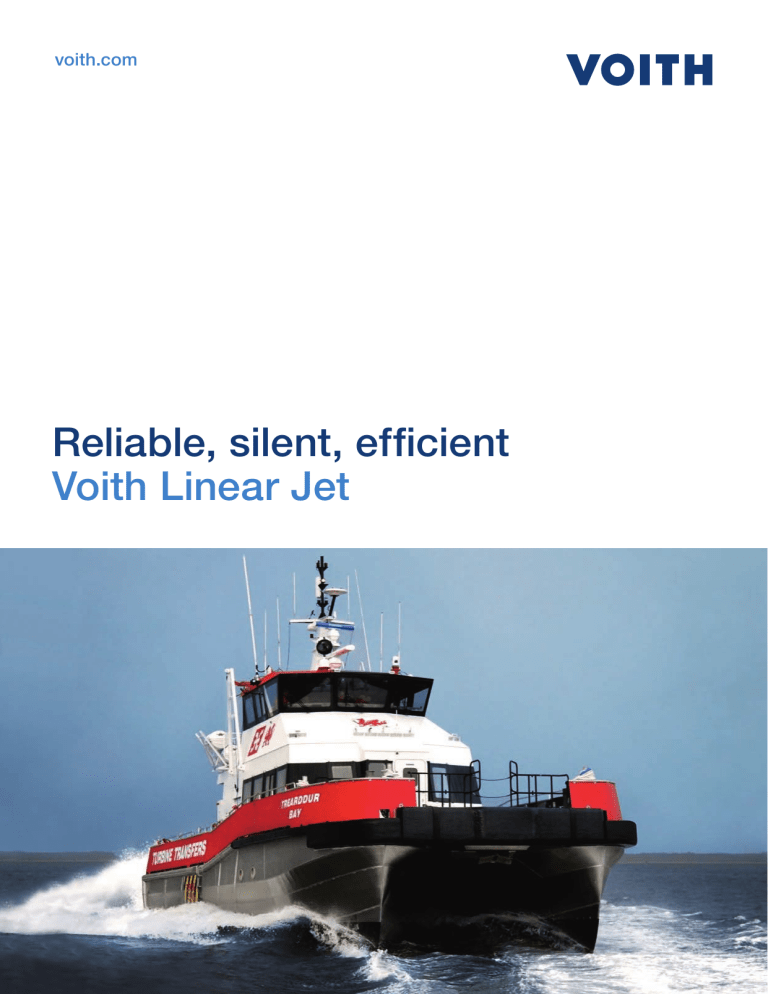
voith.com Reliable, silent, efficient Voith Linear Jet A new propulsion standard The Voith Linear Jet (VLJ) combines the best elements of two existing technologies – conventional screw propellers and water jets. Low ­installation complexity, low sensitivity to marine growth, sustained high efficiency across the vessel’s speed range and high bollard pull are benefits in common with conventional screw propellers. Reduced v ­ essel draft, the ability to reach high speeds with high efficiency and low noise and vibration levels are benefits in common with water jets. Application area The Voith Linear Jet can be installed on any ship with operating speeds up to 40 knots. Ships that will especially benefit from the hybrid nature of the Voith Linear Jet are ships with both low-speed and high-speed operating profiles. Many highspeed ships install water jets resulting in extremely high fuel consumption when the ship is loitering at low engine powers. The Voith Linear Jet then provides a solution with the ability to efficiently absorb the high power required for high-speeds, while offering from low to high-speed an almost constant high efficiency around 70 %. A yacht or a coastguard patrol vessel are typical examples of mixed operating profiles often cruising at 15 knots or less and occasionally enjoying 35 knots top speeds. For ships with top speeds of maximum 20 knots a traditional screw propeller is in general the best choice. 2 Performance prediction – the vital link between design and operation at sea To assist the Naval Architect with accurate performance predictions, Voith has developed a powerful “Numerical Towing Tank” optimized for Voith Linear Jet performance predictions in any hull form. The VLJ Numerical Towing Tank calculates all hull interaction effects and cavitation issues and provides guidelines for optimum integration and hull positioning. It is validated with several hull forms, with cavitation tunnel tests, with VLJ self propelled hulls and with sea trial data. For any customer-specific project the VLJ Numerical Towing Tank generates a full report including cavitation inception at various operating conditions, hull sinkage and trim influences and performance analysis for various possible VLJ hull positions, possible integration depths and possible shaft angles. The aim is to assist the Naval Architect in optimizing the vessel and to jointly pursue success for every project. Getting started The Voith Linear Jet is built in a fixed size range. The below graphs ­indicate the VLJ size required based on the relation between the engine power and the design speed of the vessel. For instance a ship with two 6 000 kW engines and a corresponding design speed of approx. 32 knots will need two VLJ1980’s. The correct VLJ size is thus indicated by the line above the intersection of the engine power and the design speed (see example in graph). Relation between ship speed, power and VLJ diameter PD [MW] 12.0 11.5 VLJ 1980 11.0 10.5 10.0 Please contact us for an accurate selection custom for your project. Special operational conditions like bollard pull, towing conditions or extreme low noise profiles for defense applications are not considered in above graphs and may give size selection deviations. 9.5 VLJ 1780 9.0 8.5 8.0 Power-speed intersection 7.5 7.0 VLJ 1600 6.5 6.0 VLJ 1440 5.5 5.0 VLJ 1280 4.5 4.0 VLJ 1140 3.5 3.0 VLJ 1010 2.5 VLJ 900 2.0 VLJ 800 1.5 1.0 0.6 20 25 30 35 Example: VLJ 1980 = VLJ with 1 980 mm diameter 40 v [kn] 3 A new world of propulsion Robust, low maintenance, low noise propulsor Avoiding down time is paramount for any vessel business case. The fixed pitch rotor is the only moving part of the Voith Linear jet. The rotor shaft is supported by composite water lubricated bearings only depending on the naturally induced flow for their lubrication. For directional control the required rudder technology is identical to standard rudders used in ­normal open propeller type propulsion systems. The life cycle parameters of a Voith Linear Jet are therefore similar to fixed pitch propulsors. Low noise and vibrations, shallow draft and course stability The nozzle pressure build-up in front of the rotor shifts the cavitation inception point. The double shelled and stiff nozzle enclosure around the rotor optimizes the flow fields and redirects the rotor induced helical flow. The straight inflow on the rudder avoids rudder excitation and the high rudder inflow speed improves rudder lift. The impeller is enclosed within the nozzle, which harnesses pressure pulsing and hence minimizes noise inside the boat and underwater radiated noise. The ­result is a remarkably quiet propulsion system. Low noise & vibration inside the vessel and low-radiated noise into the ­environment are a benefit for all. The possibility to deeply ­integrate the nozzle into the hull reduces vessel draft while the hydrodynamic action around the nozzle structure delivers great course stability. 1 VLJ installed in a catamaran 2 Close up of VLJ rotor-nozzle assembly 1 4 Propulsion arrangement Rudder Voith Linear Jet Diesel engine Drive line Gear box 2 5 5 6 2 1 4 3 1 Features Advantages Optimized high-speed nozzle • Delay of cavitation inception Acoustic shielding + No pressure pulses + Low noise and vibration Deletion of rotor twist Straight rudder inflow + Lower fuel burn + High rudder lift, low vibrations • Low complexity Draft reduction + Easy to construct and build + Access to shallow water areas • 2 Stator in nozzle • • 3 Standard propeller tunnel Benefits • 4 Integrated compact nozzle above the base line • Draft reduction + Access to shallow water areas + Reduced risk of grounding 5 Standard rudder technology • Low risk and low cost + Standard off-the-shelf supply by yard 6 Water-lubricated stator bearing • No shaft brackets required + Lower fuel burn + Easy installation No oil-lubricated parts • Low complexity + High reliability + No pollution risk Stabilizing effect from nozzle-hull interaction • High course stability Motion dampening + Lower fuel burn + Lower incidence of motion sickness Further technical details 6 • General scope of supply The Voith Linear Jet is supplied as standard with a stainless steel nozzle, rotor and propeller shaft. For special applications, versions with bronze rotors and cladded steel propeller shafts are available. Voith offers a standard scope of supply up to the gearbox with an intermediate shaft and intermediate shaft coupling included in product package. For the thrust absorption, the gearbox thrust bearing can almost always be used. A free standing thrust block is possible as well. The stern tube seal is available in lip and face type versions with inflatable and split seals for seal service with the vessel afloat. A full CFD performance study in the Voith Linear Jet virtual towing tank is included as well as the tunnel shape, yard supplied rudder profile evaluation and positioning advice. Driveline of the Voith Linear Jet Rotor Stern tube seal Intermediate shaft-up to gearbox Intermediate shaft coupling Propeller shaft with accessories Inner stern tube with matching water lubricated composite stern tube bearing VLJ nozzle with water lubricated stator bearing and stator flow guide vanes 7 Ship with Voith Linear Jet Comparison of cavitation extent of VLJ and standard propeller at 25 kn. 8 Ship with standard propeller “It is not a propeller boat, it is not a waterjet boat and g ­ iven what we need it drives better than either.” This is what Antony Robson, the master of the first Voith Linear Jet driven vessel said after one year of operation. 9 Application examples The Voith Linear Jet can be installed on any ship with operating speeds of up to 40 knots. Ships that will especially benefit from the hybrid nature of the Voith Linear Jet are ships with mixed operating profiles combining low-speed cruising and high-speed transits. Crew transfer vessel Bollard pull, maneuverability and transit efficiency are the main operational requirements for a workboat like a wind service support vessel. Optimized nozzles for bollard pull are available in the VLJ range. To obtain favorable transit efficiency with these high-bollard pull nozzles, a vessel-optimized hull integration study is standard for these applications. The high VLJ bollard pull values with the favorable transit efficiency allow vessel operation in higher sea states and increase the vessel’s effective operational hours per year. A real at sea comparison with waterjet driven crew transfer vessels showed a fuel burn ratio of 5 to 3, meaning that in a fleet of five Voith Linear Jet driven vessels, 2 vessels have ZERO fuel burn and are thus emission free. Yachts Draft reduction to experience all parts of the Caribbean, low noise and vibrations, and increased vessel range resulting from the high VLJ efficiency are some of the advantages that the Voith Linear Jet delivers for yachts. If high sailing speeds are preferred, the Voith Linear Jet will easily serve these requirements with a continued comfortable ride at low noise and vibration levels. For an 85 meter 10 240 kW 25+ knot yacht a maximum draft of 2 800 mm could be realized for low draft cruising with low noise and vibrations. Wind service support vessel with Voith Linear Jet Yacht with Voith Linear Jet 10 For more information http://bit.ly/29RlY2H Fast ferries Fuel burn reduction and fast berthing in port maximizing the number of daily departures will make your ferry service profitable. The low VLJ installation complexity increases availability and lowers maintenance costs. A study conducted for a 4 x 2 880 kW, 30-knot ferry comparing traditional waterjets with the Voith Linear Jet showed a total 804 kW lower power requirement for the Voith Linear Jets. With a fuel burn of 220 g per kWh and a fuel price of US$ 750 per ton, the fuel costs for 2 500 annual operation hours are reduced to US$ 331 650. Navy and Coast Guard ships Navy and Coast Guard operations require flexibility. The Voith Linear Jet delivers this with continued high efficiencies at ­loitering speeds and at top speeds of up to 40+ knots. The enhanced sailing range and mission capabilities will serve the vessel’s versatility and usability. Low marine growth sensitivity maintains performance at a continued high level. The VLJ ­discharge under the waterline reduces the acoustic signature. Fast ferry equipped with Voith Linear Jet Coast Guard with Voith Linear Jet 11 VT2290, en, 2021-09, BDI. Dimensions and illustrations without obligation. Subject to modifications. Please scan QR-Code to get further information: Voith Group St. Poeltener Str. 43 89522 Heidenheim, Germany Contact: Phone + 49 7321 37-2055 marine@voith.com www.voith.com/marine Please scan QR-Code to contact our experts:
